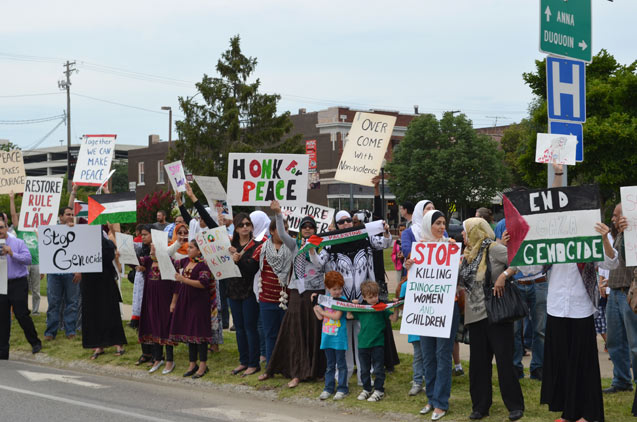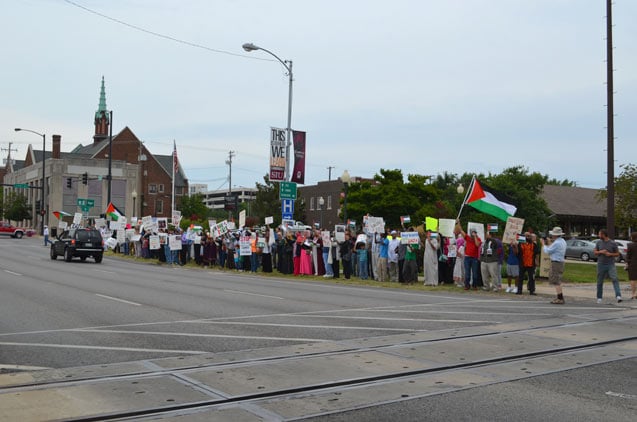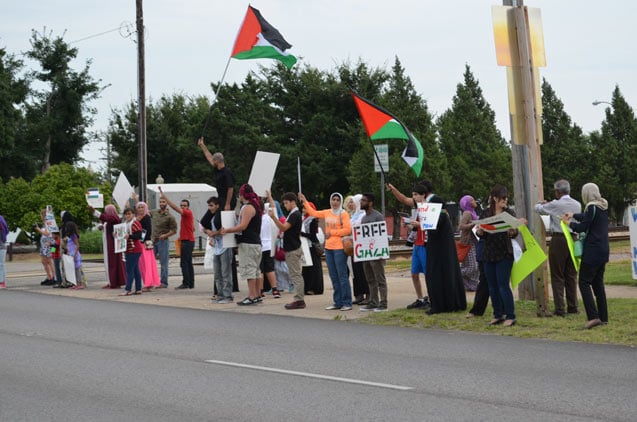
Two days after the United Nations Human Rights Council adopted a resolution to investigate violations of human rights in the Occupied Palestinian Territory as a result of Israel’s “Operation Protective Edge,” people lined Main Street in Carbondale, Ill., to show solidarity with Gaza and condemn the Israeli assault.
When the Human Rights Council convened an emergency meeting on July 23 and adopted the resolution for an inquiry into potential human rights law violations, the United States was the only nation to cast a negative vote against it.
Abdallah, a young adult from Marion, Ill., held a Palestinian flag and said he hoped the demonstration would “spread awareness in Southern Illinois – not just in Southern Illinois, but all of America,” so that citizens know “in Gaza right now, we have innocent children dying” because of Israel’s military operation, backed by the US.
 (Photo: James Anderson)
(Photo: James Anderson)
In 2013, the US sent Israel $196 million in parts for the sort of planes and helicopters used in the attacks on Gaza, according to an analysis of US Census Bureau export data conducted by Ken Klippenstein and Paul Gottingner. From January to May 2014, the US exported $96 million in similar military parts, they added.
An analysis by Thalif Deen points also to the Foreign-Military-Financing the US provides Israel. Deen noted non-repayable grants from the US to Israel are for the purchase of US-made weapons, and Israel received a 10-year, $30 billion military aid package from the US that runs from 2009 through 2018.
The Israeli assault that started July 8 has killed more than 800 Palestinians, destroyed a school run by the United Nation Relief and Works Agency for Palestine Refugees, andshelled the Al-Aqsa Hospital in Gaza’s middle zone. Demonstrators, near the intersection of Illinois Avenue and Main Street in Carbondale, attempted to draw attention to the ongoing crisis and its history.
 (Photo: James Anderson)
(Photo: James Anderson)
In “Gaza in Crisis,” co-authored with Israeli historian Ilan Pappé, Noam Chomsky documented the history of the protracted crisis, citing examples of past Israeli attacks against Palestinians. Chomsky explained how “in June 1982 the U.S.-backed Israeli invasion of Lebanon opened with the bombing of the Palestinian refugee camps of Sabra and Shatila, later to become famous as the site of the terrible massacres supervised by the IDF [Israeli Defense Forces].” In that 1982 invasion, a bomb hit the Gaza hospital, Chomsky added, and the assault proceeded with “crucial U.S. military and diplomatic support,” including “vetoes of Security Council resolutions seeking to halt the criminal aggression that was undertaken, scarcely concealed, to defend Israel from the threat of peaceful political settlement.”
Abdallah waved a Palestinian flag on Friday, July 25, while people nearby held a banner reading “End the Siege,” as cars headed west on Main Street witnessed the sea of pro-peace advocates calling for a ceasefire and a lifting of the seven-year siege on Gaza. The siege, enforced by Israel, prevents essential goods and medicines from entering while also keeping Palestinians from leaving. Exit through Egypt has also been blocked off since the military coup brought Abdel Fattah el-Sisi to power. As Egyptian president, el-Sisi has been hostile to the Muslim Brotherhood, and Hamas, the organization governing the Gaza Strip, is considered to be the Brotherhood’s political counterpart in the Occupied Territories.
 (Photo: James Anderson)
(Photo: James Anderson)
Ibrahim, Abdallah’s friend, said most media outlets only focus on one side with framing that portrays Palestine poorly. Headlines in major newspapers like, “Hamas Gambled on War as Its Woes Grew in Gaza,” from the New York Times, and “Israel accepts truce plan; Hamas balks,” at the Washington Post elide the realities of the blockade, a form of economic warfare that Palestinians and supporters say renders condition in Gaza unbearable even when bombs are not being dropped.
Abdallah and his friends said that with growing resistance throughout the Occupied Territories, if Israel’s assault and imposed blockade continue, a third intifada is imminent.
“History is repeating itself and the whole world isn’t watching,” said Ahmed Amley, a friend of Abdallah’s.
Truthout Is Preparing to Meet Trump’s Agenda With Resistance at Every Turn
Dear Truthout Community,
If you feel rage, despondency, confusion and deep fear today, you are not alone. We’re feeling it too. We are heartsick. Facing down Trump’s fascist agenda, we are desperately worried about the most vulnerable people among us, including our loved ones and everyone in the Truthout community, and our minds are racing a million miles a minute to try to map out all that needs to be done.
We must give ourselves space to grieve and feel our fear, feel our rage, and keep in the forefront of our mind the stark truth that millions of real human lives are on the line. And simultaneously, we’ve got to get to work, take stock of our resources, and prepare to throw ourselves full force into the movement.
Journalism is a linchpin of that movement. Even as we are reeling, we’re summoning up all the energy we can to face down what’s coming, because we know that one of the sharpest weapons against fascism is publishing the truth.
There are many terrifying planks to the Trump agenda, and we plan to devote ourselves to reporting thoroughly on each one and, crucially, covering the movements resisting them. We also recognize that Trump is a dire threat to journalism itself, and that we must take this seriously from the outset.
Last week, the four of us sat down to have some hard but necessary conversations about Truthout under a Trump presidency. How would we defend our publication from an avalanche of far right lawsuits that seek to bankrupt us? How would we keep our reporters safe if they need to cover outbreaks of political violence, or if they are targeted by authorities? How will we urgently produce the practical analysis, tools and movement coverage that you need right now — breaking through our normal routines to meet a terrifying moment in ways that best serve you?
It will be a tough, scary four years to produce social justice-driven journalism. We need to deliver news, strategy, liberatory ideas, tools and movement-sparking solutions with a force that we never have had to before. And at the same time, we desperately need to protect our ability to do so.
We know this is such a painful moment and donations may understandably be the last thing on your mind. But we must ask for your support, which is needed in a new and urgent way.
We promise we will kick into an even higher gear to give you truthful news that cuts against the disinformation and vitriol and hate and violence. We promise to publish analyses that will serve the needs of the movements we all rely on to survive the next four years, and even build for the future. We promise to be responsive, to recognize you as members of our community with a vital stake and voice in this work.
Please dig deep if you can, but a donation of any amount will be a truly meaningful and tangible action in this cataclysmic historical moment. We are presently looking for 201 new monthly donors in the next 24 hours.
We’re with you. Let’s do all we can to move forward together.
With love, rage, and solidarity,
Maya, Negin, Saima, and Ziggy